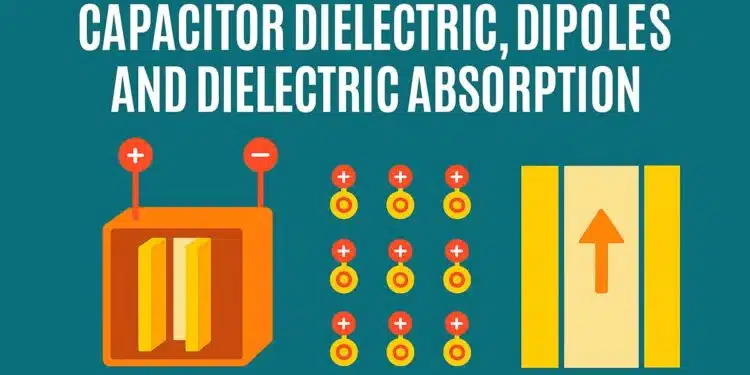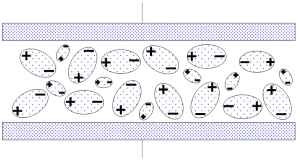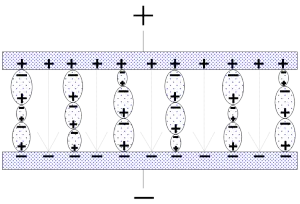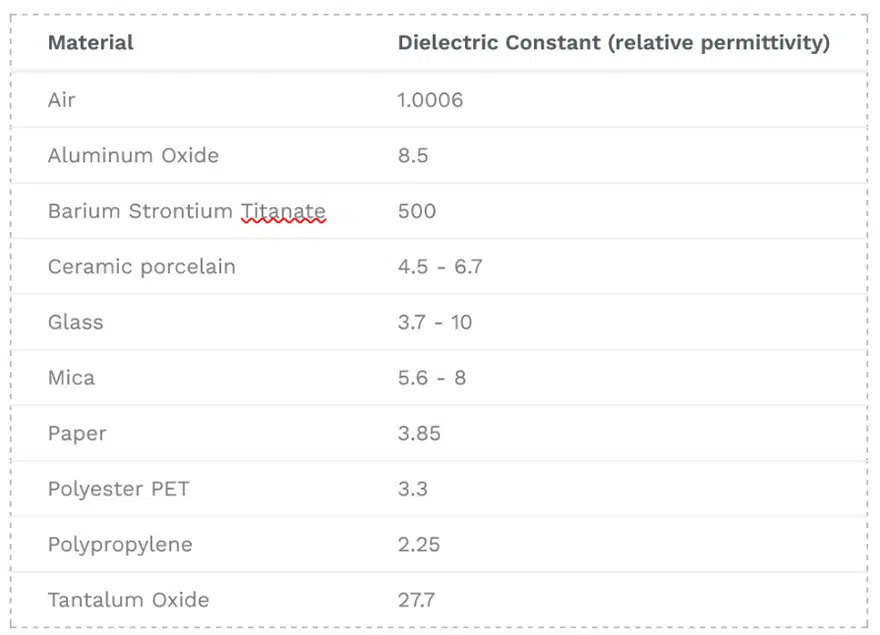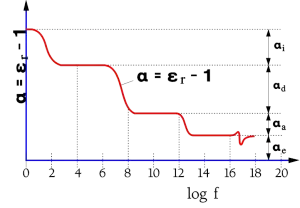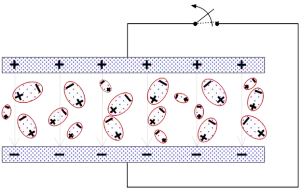this article explains capacitor dielectric material constant (permittivity), and how it is formed by dipoles and dielectric absorption.
Key Takeaways
- The article explains the capacitor dielectric material constant (permittivity) and its formation from dipoles and dielectric absorption.
- Capacitors contain conductive plates separated by dielectric material, which polarizes when voltage is applied, affecting capacitance.
- Dielectric constants determine how much electrical energy a capacitor can store, with higher constants indicating better energy storage.
- Dielectric absorption (DA) is the residual voltage in capacitors, resulting from dipole activation and can complicate circuit design.
- Factors such as temperature and frequency influence dielectric behavior, affecting the selection of materials for capacitors.
A typical capacitor comprises two conductive plates and a non-conductive dielectric material. The dielectric material separates the two conductive metal electrode plates. Applying voltage to the electrode plates of a capacitor causes an electric field in the non-conductive dielectric material. This electric field stores energy. The dielectric constant, also commonly known as relative permittivity, is the measure of the ability of a material to store electrical energy, and is one of the key properties of a dielectric material.
The capacitance of a parallel plate capacitor is a function of distance between plates, plate area, and dielectric material constant. An increase in plate area and dielectric constant results in an increase in capacitance while an increase in the separation distance between the plates results in a decrease in capacitance. Different dielectric materials have different dielectric constants.
Dipoles
The section about dipoles and of dielectric absorption is of vital importance for the understanding of the practical capacitor. All materials contain some kind of dipoles, i.e. electrically polar elements. When they are subjected to an electric field it creates a torsional moment which, depending on the field strength, will tend to align them in this field. These torsional moments can be divided into four groups. Those which are caused by
- electron movements in atoms and molecules,
- atom movements in symmetrical molecules,
- atom movements in unsymmetrical molecules and
- charge accumulations on interfaces between different materials in the dielectric.
As long as the capacitor is not biased, the dipoles have a random orientation, without any resulting pole. It may in principle looks like the Figure 8.
If they should be subjected to an electric field strength as in Figure 6. they will after a specific time tend to be aligned in dipole chains. The dielectric material has been polarized.
The electric field strength (the number of imaginary field lines which would have formed in vacuum) has been reduced with the number of established dipole chains. Every dipole chain binds in the interface towards for example the positive electrode a + charge and the number of free charge carriers in the electrode has been reduced to a corresponding degree. Thus, after the alignment time of the dipoles, the electrode is able to receive as many new free charge carriers as those the dipole chains have bound without creating an increase of the electric field strength (or the voltage) above that of the starting point. This means a corresponding increase in capacitance. If we call this polarizability , the number of bound charges q and the number of charges at the starting point Q, it can be shown that
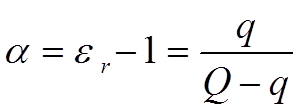
……………………. [7]
The function of a versus frequency is shown in Figure 11. below.
Because εr depending on dielectric material varies approximately between two and many thousands we realize what an enormous significance the material dipoles and the polarizability plays.
Effects of dielectric constant on the characteristics of a capacitor
The dielectric material of a capacitor polarizes when voltage is applied. This process reduces the electric field and causes negatively charged electrons to shift slightly towards the positive terminal. Although the electrons do not shift far enough to cause a flow of current, the process creates an effect that is critical to the operation of capacitors. Removing the source of voltage causes the dielectric material to lose polarization. However, if the material has weak molecular bonds, it can remain in polarized state even when the source of voltage is removed.
A capacitor stores energy in the electric field when a voltage is applied. The capacity to store electrical energy varies from one dielectric material to another. The amount of electrical energy that a capacitor can store is influenced by the amount of polarization that occurs when voltage is applied. Materials with high dielectric constants can store more energy compared to those with low dielectric constants. The electric susceptibility of a material is a measure of the ease with which it polarizes in response to an electric field. Good dielectric materials have high electric susceptibility.
The dielectric constant is one of the key parameters to consider when selecting a dielectric material for a capacitor. This constant is measured in farads per meter and determines the amount of capacitance that a capacitor can achieve. Dielectric materials with high dielectric constants are used when high capacitance values are required, although, as mentioned above, other parameters that determine the capacitance of a capacitor include the spacing between the electrodes and the effective plate area.
Dielectric constants of common dielectric materials
All materials are capable of storing electrical energy when they are exposed to an electric field. The storage capacity varies from one material to another. The permittivity of materials is usually given relative to the permittivity of free space, usually symbolized by ϵ0. The permittivity of vacuum is commonly known as absolute permittivity and refers to the amount of resistance required to form an electric field in a vacuum. The absolute permittivity of free space is approximately 8.85418782 × 10-12 m-3 kg-1 s4 A2.
The permittivity of a dielectric material relative to that of free space is referred to as relative permittivity, usually symbolized by ϵr, or dielectric constant. The following equation relates absolute permittivity (ϵ0), relative permittivity or dielectric constant (ϵr), and permittivity of a material (ϵ).
ϵr = ϵ x ϵ0
The table below shows the dielectric constants of commonly used dielectric materials.
There are many other materials with dielectric properties, overview of dielectric constant on wide range of organic plastic materials is provided in the article here.
Variations in temperature cause discontinuities in the permittivity of a dielectric material, and have a significant effect on the dielectric constant of a material. For instance, an increase in temperature causes a decrease in permittivity, and the dielectric constant of a material drops sharply when the temperature falls below the freezing point.
When selecting a dielectric material for a capacitor, it is also important to consider the effect of frequency on the material’s properties. The permittivity that a material exhibits when it is exposed to an electric field is dependent on the frequency of the voltage source. When a material is placed in a static electric field, the permittivity that it exhibits is referred to as static permittivity. The permittivity of a material decreases with an increase in frequency of the voltage source.
A primary drive today is towards circuit miniaturisation. To produce miniature circuits components with a smaller footprint are required. The dielectric constant of a capacitor determines the capacitance that can be achieved. Dielectric materials with high dielectric constants are used when capacitors with smaller physical sizes are required.
Apart from dielectric constant, it is also important to consider dielectric loss and dielectric strength when selecting a dielectric material for a capacitor. The dielectric strength is a measure of the voltage that an insulator will withstand before it allows current to flow through it. The dielectric loss refers to the energy that a dielectric material dissipates when a variable voltage is applied.
Frequency dependence of capacitance
The velocity with which a dipole react for an applied electric field is called its relaxation time. These relaxation times range from 10-17 s for the electron dependent dipoles to several hours for the large molecular complexes. That means that the fastest dipoles keep up with all practical frequencies while the slower to a varying degree need time to contribute with capacitance-increasing dipole chains. The phenomenon can be described as a basic capacitor combined with a number of additional capacitor elements hidden in resistive circuits with shorter or longer time constants (Figure 10.).
An example of the frequency range that different types of dipoles contribute to is shown in Figure 11.
- αe = dipole effect from electron movements;
- αa = dipole effect from atom movements in symmetrical dipoles;
- αd = dipole effect from atom movements in unsymmetrical molecules;
- αi = interface dependent dipoles.
Figure 11. Typical example of schematic variance of polarizability in a solid material with frequency.
Thus, the capacitance decreases with increasing frequency. In components with large dielectric losses and a considerable percentage of inert dipoles we will learn how the impedance curve starts deviating from the nominal capacitive reactance curve when we approach the resonance frequency.
Dielectric absorption
If the dipoles have been ”activated” to form a dipole chain it will take a corresponding time to “deactivate” them at the same temperature. In Figure 12. it is presupposed that the capacitor first has been charged, then momentarily short circuited and finally left open. Those dipole chains which were too inert to react during the short circuiting moment kept their charges captured in the electrode. After a while in the absence of an electric field they begin to assume random, unaligned positions, releasing the captured charges in the electrodes (Figure 12.). The released charges are manifested as a residual voltage in the capacitor and is measured in V. This residual voltage is a measure on the dielectric absorption ”DA” of the capacitor and is expressed in percent of the initial voltage applied.
Figure 12. Effect of dielectric absorption.
DA is generally an unwanted property which burdens certain dielectric materials severely, others little or quite negligibly. It may sometimes cause problems we will discuss later.
The determination of DA is made by biasing the capacitor with a DC voltage for a certain period of time, then short circuiting the part over a resistor for a specified number of seconds and finally leaving it open for a number of minutes before the residual voltage is read. It is expressed in percent of the charging voltage. Voltages, times and resistances are specified in different standards which sometimes differ. Examples of how the times influence the results are shown in Table 3 where the records are done at 25 °C. DA increases strongly with rising temperature.

Knowledge of the dielectric absorption of capacitors is often vital for optimum circuit design. Thus we will provide DA values in the part summaries following every material group. Primarily, the values are obtained based on procedures the same as or equal to either of the methods in Table 3. above.
Table 4. below shows a typical most common capacitor technologies’ dielectric absorption values:
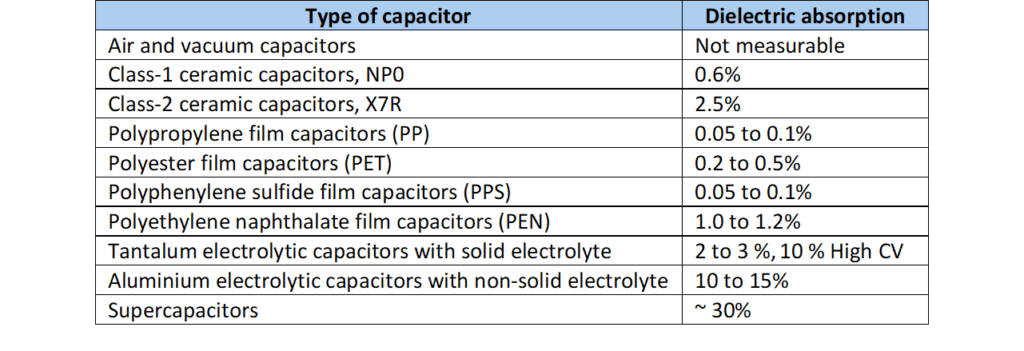
Conclusion
A dielectric material is used to separate the conductive plates of a capacitor. This insulating material significantly determines the properties of a component. The dielectric constant of a material determines the amount of energy that a capacitor can store when voltage is applied. A dielectric material becomes polarized when it is exposed to an electric field. When polarization occurs, the effective electric field is reduced. Since the permittivity of a material is dependent on frequency and temperature, the dielectric constant is usually given at specific conditions, usually at low frequencies. Moreover, the dielectric constant of a material is usually given relative to the permittivity of free space.
FAQ: Dielectric, Permittivity, Dipoles and Dielectric Absorption
A dielectric is a non-conductive material placed between capacitor plates. It stores energy by polarizing under an electric field, reducing the effective field strength and enabling capacitance.
The dielectric constant, or relative permittivity (εr), measures a material’s ability to store electrical energy compared to vacuum. Higher values allow higher capacitance in smaller component sizes.
Dipoles inside dielectric materials align with an applied electric field, forming chains that increase capacitance. Their response depends on frequency and relaxation time, influencing performance.
Dielectric absorption is the residual voltage that appears after a capacitor is charged, discharged, and left open. It results from slow dipoles releasing stored charges and is usually an unwanted effect.
It determines capacitance, energy storage, and miniaturization potential. Designers must also consider dielectric loss, strength, frequency, and temperature dependence when selecting materials.



















